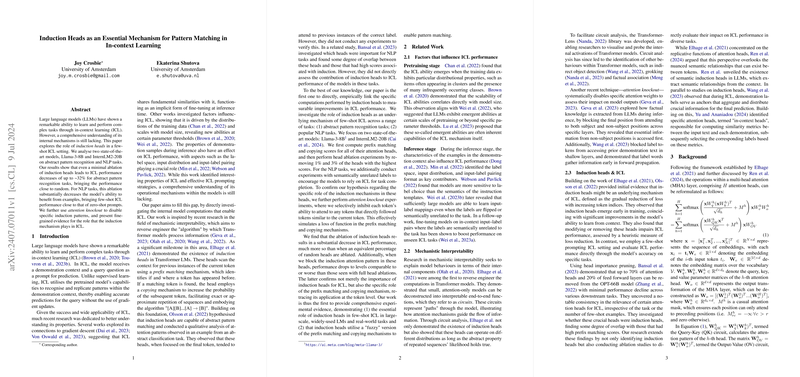Induction Heads as an Essential Mechanism for Pattern Matching in In-context Learning
The paper, "Induction Heads as an Essential Mechanism for Pattern Matching in In-context Learning", explores the critical role of induction heads within the framework of in-context learning (ICL) in LLMs. The authors primarily focus on two state-of-the-art models: Llama-3-8B and InternLM2-20B, examining their pattern recognition capabilities in both abstract and real-world NLP tasks.
Core Findings
Induction heads have been identified as integral components in transformer models, specifically in facilitating ICL. These attention heads are noted for their prefix matching and copying abilities, which enable the models to perform pattern matching and sequence prediction. Through methodical ablations, where 1% and 3% of the top-performing induction heads were deactivated, the paper reveals that the performance on ICL tasks significantly declines. For instance, in abstract pattern recognition tasks, this ablation results in up to a 32% performance reduction, rendering the LLMs' outputs close to random guessing. In NLP tasks, the impact is evident in a marked reduction in the advantage typically gained from few-shot examples.
The paper further substantiates the pivotal function of induction heads through attention knockout experiments, simulating a loss of crucial pattern recognition functionality. These experiments show that merely inhibiting the induction patterns within selected heads drastically impacts performance, highlighting their dependence on this specific mechanism for ICL.
Practical and Theoretical Implications
The findings underscore the foundational role induction heads play in enhancing the few-shot learning capabilities of LLMs. This contributes to the understanding of how LLMs leverage context to draw parallels and generalize from small datasets, aligning with strategies witnessed in human cognitive learning. Practically, this suggests avenues for refining transformer architectures to further optimize their pattern recognition abilities.
Theoretically, this research opens several avenues for exploring the internal computations of LLMs. By outlining a clear empirical link between induction heads and ICL, the paper paves the way for more intricate models of cognitive processing in artificial systems. This work also serves as a reference point for further dissection of attention mechanisms within LLMs, which could lead to the development of more efficient and robust models.
Future Speculations
Given these insights, future developments in AI could focus on refining the induction mechanisms within transformer models to enhance generalization from limited data. Further research might explore the integration of advanced induction mechanisms in specialized AI systems tailored for tasks requiring nuanced pattern recognition or decision-making under uncertainty.
In conclusion, this paper provides comprehensive experimental evidence that induction heads are not merely supplementary components but are a fundamental machinery in pattern-driven LLMs. Understanding and harnessing this capability could herald new innovations in the design of LLMs, pushing the boundaries of what AI can achieve in understanding and mimicking human-like learning processes.
